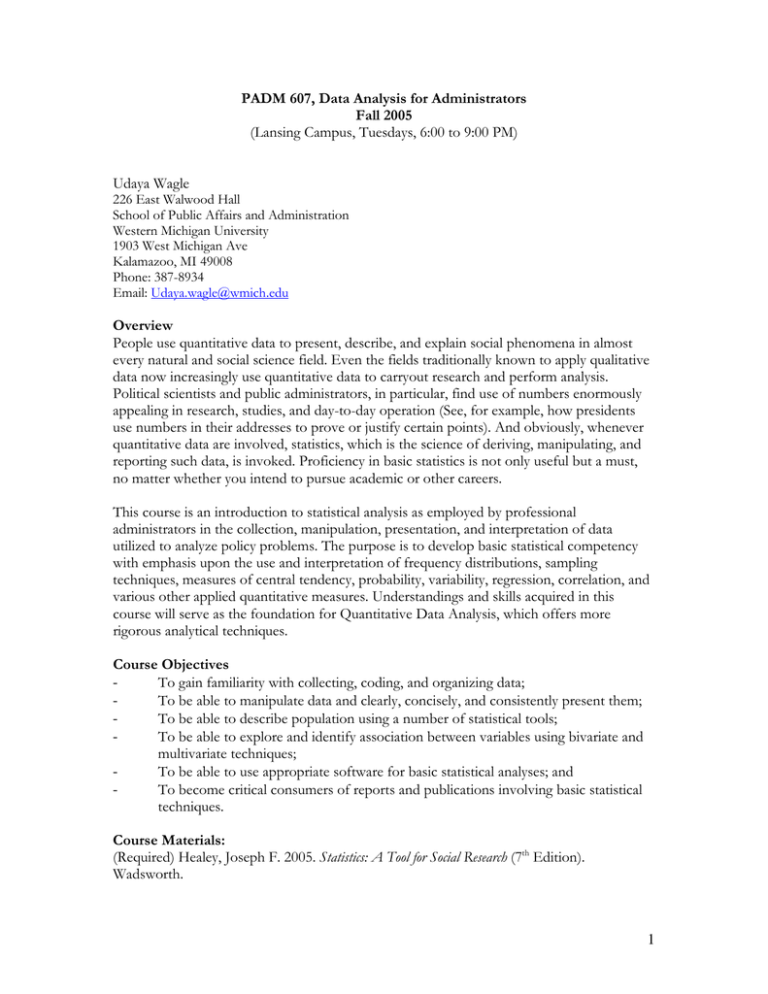PADM 607, Data Analysis for Administrators Fall 2005
advertisement

PADM 607, Data Analysis for Administrators Fall 2005 (Lansing Campus, Tuesdays, 6:00 to 9:00 PM) Udaya Wagle 226 East Walwood Hall School of Public Affairs and Administration Western Michigan University 1903 West Michigan Ave Kalamazoo, MI 49008 Phone: 387-8934 Email: Udaya.wagle@wmich.edu Overview People use quantitative data to present, describe, and explain social phenomena in almost every natural and social science field. Even the fields traditionally known to apply qualitative data now increasingly use quantitative data to carryout research and perform analysis. Political scientists and public administrators, in particular, find use of numbers enormously appealing in research, studies, and day-to-day operation (See, for example, how presidents use numbers in their addresses to prove or justify certain points). And obviously, whenever quantitative data are involved, statistics, which is the science of deriving, manipulating, and reporting such data, is invoked. Proficiency in basic statistics is not only useful but a must, no matter whether you intend to pursue academic or other careers. This course is an introduction to statistical analysis as employed by professional administrators in the collection, manipulation, presentation, and interpretation of data utilized to analyze policy problems. The purpose is to develop basic statistical competency with emphasis upon the use and interpretation of frequency distributions, sampling techniques, measures of central tendency, probability, variability, regression, correlation, and various other applied quantitative measures. Understandings and skills acquired in this course will serve as the foundation for Quantitative Data Analysis, which offers more rigorous analytical techniques. Course Objectives To gain familiarity with collecting, coding, and organizing data; To be able to manipulate data and clearly, concisely, and consistently present them; To be able to describe population using a number of statistical tools; To be able to explore and identify association between variables using bivariate and multivariate techniques; To be able to use appropriate software for basic statistical analyses; and To become critical consumers of reports and publications involving basic statistical techniques. Course Materials: (Required) Healey, Joseph F. 2005. Statistics: A Tool for Social Research (7th Edition). Wadsworth. 1 (Highly recommended) Intercooled Stata 9 (data analysis software) Order the software by visiting http://www.stata.com/order/new/edu/gradplans/gp2-order.html (specify SPAA607 for the course ID). Install and try to familiarize yourself with its basic features. (Recommended) Lawrence C. Hamilton. 2004. Statistics with Stata, Version 8 (5th Edition) (ISBN 0534997562). Brooks/Cole (On Reserve) Mann, Prem S. 2005. Statistics Using Technology. John Wiley and Sons. Delivery Method Classes will involve both traditional lecture presentation and lab demonstration. When it comes to using computer software, how much time you spend and how much guided practice you do really matters. I, therefore, expect you to familiarize yourself with the software as much as possible by using it at your home. Performance Evaluation There will be weekly problem sets to be completed either by hand or by using software (I will try to minimize the number of problem sets to be completed by hand). However, there will be midterm and final exams to be completed in class including multiple choice and true/false questions, short answer questions, and short exercise to be completed by hand. Additionally, your active participation counts in this course with a lot of in-class lab demonstrations. Following is the distribution of weights for each group of assignments. Weekly problem sets Midterm exam Final exam Participation Total 30% 30 30 10 100 I will use the following as a general guide (all in percentage terms) to determine your letter grade. Some adjustments may occur, however, especially on exams, depending on the performance of the entire class. A ≥ 95 95>BA ≥ 90 90>B ≥ 85 85>CB ≥ 80 80>C ≥ 75 75>DC ≥ 70 70>D ≥ 65 D>E (Fail) Academic Honesty You are responsible for making yourself aware of and understanding the policies and procedures in the Graduate Catalog (pp. 25-27)] that pertain to Academic Honesty. These policies include cheating, fabrication, falsification and forgery, multiple submission, plagiarism, complicity and computer misuse. If there is reason to believe you have been involved in academic dishonesty, you will be referred to the Office of Student Conduct. You 2 will be given the opportunity to review the charge(s). If you believe you are not responsible, you will have the opportunity for a hearing. You should consult with me if you are uncertain about an issue of academic honesty prior to the submission of an assignment or test. Weekly meetings 1. 8/30 Basics Chs. 1 and 2, Appendix G (I also recommend reviewing Appendix H for basic mathematical skills) 2. 9/6 Describing Population Chs. 3 and 4 3. 9/13 Probability and Probabilities of Discrete Random Variables Chs. 4 and 5 from Mann, 2005, Statistics Using Technology. 4. 9/20 Probability (continue) and Normal Curve Ch. 5 5. 9/27 Sampling and Estimation Chs. 6 and 7 6. 10/4 Mid-term Exam 7. 10/11 Hypothesis Testing: One and Two Sample Cases Chs 8 and 9 8. 10/18 Hypothesis Testing: Chi Square Ch. 11 9. 10/25 Hypothesis Testing: ANOVA Ch. 10 10. 11/1 Bivariate Association Chs. 13 and 16 11. 11/8 Multivariate Association Chs. 17 and 18 12. 11/15 Final Exam 3
